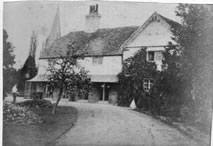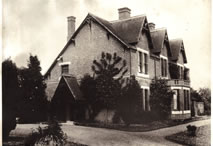The Vicarages
The Vicarages
There are known to have been at least four vicarages in the village. The first mention of a vicarage was in 1636 when it was recorded that there was ‘one dwelling house … commonly called … the Vicarage House, one little barn, one stable, one gate place’ . Although its location is not known, it would have been somewhere in the area now covered by the present vicarage, Glebe Way and Farnfold. This whole area was originally owned by the church and was known as the ‘glebe’, which meant land belonging to the parish where a vicarage stands. Most of it was sold for development in 1963 when the present vicarage was built.

Pre 1868
Sometime in the eighteenth century a handsome Georgian building replaced the first vicarage. It was probably located in the eastern part of the vicarage grounds and was fronted by a curved drive leading from the main road, probably at the junction with the lane to Champion Farm. The earliest known photograph taken in the village shows this building sometime before the building was demolished.
In 1867, the resident vicar, the Revd. Maze Gregory, demolished the Georgian vicarage. He replaced it with a large Victorian one located just to the east of the present vicarage. It was fronted by a huge lawn that became very popular as the venue for fetes and garden parties during the 1930’s in the days of the Revd. Richard Edwards.

Pre 1963
The Victorian vicarage was accessed by a drive leading from where Glebe Way meets the main road. In those days, of course, Glebe Way did not exist. Instead, there was a shady paved path called Holy Water Lane that ran from the south-eastern churchyard gate to the main road and then continued alongside Harsfold Lane to Simmonds Bridge. It is reputed to have been used long ago to fetch river water for church use. Unfortunately, the northern part of this path was lost when Glebe Way was built.
The vicarage was commandeered by the army during the Second World War and was used as an office mess by British and Canadian officers. Canadian troops pitched their tents in the grounds in the weeks preceding the Dieppe raid. The main entrance was directly opposite Harsfold Lane. It had two brick pillars with brick walls on each side. On one occasion a tank going into the vicarage accidentally demolished the right-hand pillar. During the war, some people thought that military vehicles, especially tanks, were generally driven rather carelessly, and at times very aggressively towards structures such as walls.
After the war, from 1947, Revd. Randall Williams lived there. He was very benevolent towards the choir boys and permitted them to build a tree house in the vicarage grounds which they constructed on the eastern side near a path in the grounds called Monks’ Walk. There were rumours that monks used to walk along this path many centuries ago; whether or not this was true, it was enough to scare the choirboys when they played in their tree house on dark winter evenings.
The source of the belief that monks walked through the grounds is not known. Many rumours have a kernel of truth buried somewhere in them, so perhaps there is some truth in it. Any monks would have been based at the Benedictine monastery that was believed to exist in the village. It has been suggested that the stones from this were used to build the workhouse after its demolition. The location of the supposed monastery is not known; some have suggested that the workhouse was built on the monastery site, though there is no evidence for this.
The Revd. John Penney lived there from 1951 until the greater part of the vicarage grounds was sold off in 1963 for development. The present vicarage was built to the west of the Victorian one. Glebe Way and Farnfold were built on the remainder of the original grounds after the Victorian vicarage was demolished. The History Group has a photo showing the present one just finished and the western remnant of the old one being demolished.
